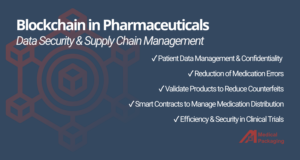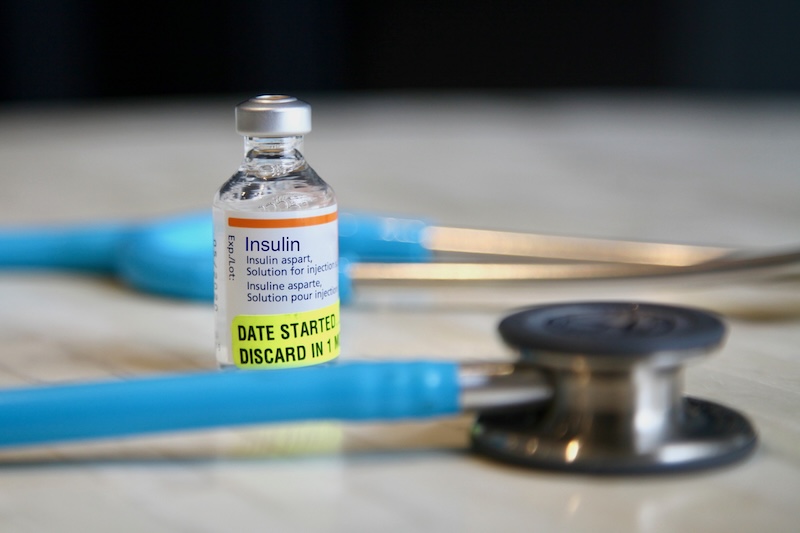The blockchain is the technological revamp of the public ledger. Though it is most often associated with the financial world, technology can be applied to nearly any industry. This shared database groups transactions and then protects them with a unique signature for each category. A blockchain network is not only more efficient than alternative record keeping, but it is also safer. Blockchains in the pharmaceutical industry can securely record data in real-time and protect it from being altered in the future.
In healthcare, the blockchain is a potential solution to protect patient data and manage the complex supply chain of pharmaceuticals. This can have a marked effect on how facilities operate, particularly when it comes to how they stock shelves and what is stocked on them. With Americans spending more and more every year on healthcare, there has never been more demand for stronger support in the industry.
As a leading provider of packaging software and systems in the pharmaceutical industry, Medical Packaging Inc., LLC shares key information on how this technology is evolving and how it impacts the many stakeholders involved in the pharmaceutical supply chain process.

Data Security
Patient data is the cornerstone for a practitioner’s course of treatment, though organizing, sharing, and protecting that information has long plagued small clinics and large hospitals alike. To make matters worse, every organization has taken its own approach to the problem, which has led to extreme gaps in processes for patients switching providers. Some people are used to seeing their information on a digital chart, which they can access through two-factor authorization. Others must rely on their doctor to make photocopies of their medical records, and then they must pay the doctor for the cost of the supplies.
With all of the digital assets at our fingertips, regulations like HIPAA have imposed ever stricter laws to ensure practitioners keep their patient’s data safe. That is why data management systems of today may have a robust backup plan, such as impenetrable encryption for all patient files. However, there are more likely to be holes in the security that administrators are not even aware of until they are facing the consequences of a lax system.
When healthcare organizations transition to the blockchain, even the most dedicated criminals in the world would find it impossible to manipulate its contents. The blockchain is a transparent log that can conceal identities without concealing pertinent information. If an investigator wants to verify which doctor issued a specific prescription or a specialist wants to access certain key information about the patient, they can rely on distributed ledger technology to assess the facts.

Managing the Pharmaceutical Supply Chain
In any industry, it is important to manage the supply chain, but in the pharmaceutical industry, the stakes are at their peak. Disruptions along the pharma supply chain aren’t just an inconvenience, they can cost people their lives. There are around 19,000 prescription drugs that have been approved for marketing in the US. Given the demand and the scope of the operation, it is no wonder the drug supply chain is rife with opportunities for genuine errors and criminal mischief alike.
Even with the restrictions imposed by regulatory bodies, oversight is not always what it should be. Unfortunately, the country has seen a rise in counterfeit medicines and falsified drugs. The US market for pharmaceuticals in 2023 is expected to surpass $1.5 trillion, and the estimate for counterfeit products is around 3.3%. A blockchain solution is not the only answer to this problem, but it is one worth exploring for healthcare practitioners.
Blockchain companies in this space can increase accountability across the cold chain, reshaping the tracking methodologies and ensuring that each party along the way holds up their end of the transaction. Smart contracts on a blockchain solution can automatically run protocols that accurately document the chain of events. Nonprofits like the Global Fund and the Red Cross may find it especially helpful as they traffic donated medications around the world. With the blockchain-based system, each product can have security features that make it possible to distinguish the real thing from the fakes.

Stakeholders in Blockchain Technology
Different stakeholders in the pharmaceutical industry have different things to gain through the implementation of distributed ledger technology:
- Manufacturers: Manufacturers of legit drugs can ensure that drugs are going where they are supposed to go and that each product arrives completely intact.
- Logistical services: The sheer number of parties involved in pharmaceuticals make for a logistical nightmare for even the most experienced services. The blockchain makes it possible to trigger one event after another until the product reaches the end user.
- Distributors: Much like logistical services, the blockchain makes it easier for distributors to fully track how each pharmaceutical is moved.
- Healthcare markets: While spending in healthcare markets may be high, the public’s trust in healthcare is relatively low. The blockchain can bolster public trust by cutting down on counterfeit drugs and on drug shortages.
- Patient safety: The improvement of drug administration through better supply chain management means better patient access to the right pharmaceuticals.
With so many parties involved in the final sale of a prescription drug, having verifiable information is of the utmost priority. Being able to quickly assess how and where an error occurred, or if an error was made at all, is the only way to improve each link in the chain.

Blockchains in Clinical Trials
Clinical trials track the interactions of a pharmaceutical within a given population, and their results have everything to do with a drug’s viability. If the results are skewed or corrupted, it is more than money on the line. With blockchain, there is a way for all data to be securely recorded and then shared throughout a community. If there is a problem with how the trial was conducted, it is easier for peers to review and confirm the validity of the data. From the sample size to the collection methodology, colleagues can view the clinical trial in context with the rest of the publications on the topic. In addition, the blockchain keeps the identities of all trial participants hidden from view.
Sensitive data from a clinical trial, such as who is taking a placebo or what type of symptoms a patient develops, can not only be updated in real-time on a blockchain, but it can also be done in a way that minimizes the odds of error. Doctors may even be able to recruit more people to the trial, which can improve the credibility of their findings. The original blockchain was developed with the goal of storing and protecting all the world’s financial transactions, so it is not a question of scale.
Regulatory Concerns
The blockchain was designed to help patients maintain their privacy. However, that does not mean implementation for healthcare organizations is as simple as choosing a reputable blockchain company. Regulations like HIPAA and GDPR are often up for interpretation, which can make it difficult for some people to reconcile where a new technology fits in.
Luckily, the blockchain satisfies the spirit of these rules, which despite the different acronyms, all share the same basic common themes. With a private blockchain, the number of parties can be limited to those that need the data. However, despite these benefits, not everyone is convinced of the blockchain’s ability to protect data according to the law. For instance, patients have the right to be forgotten, which is currently impossible to accomplish with an unchangeable ledger — even a private one. It seems clear that there will be some degree of clarification in the future, though there is no telling just how much back-and-forth there will be before either side is satisfied.

The Future of Blockchain in the Pharmaceutical Industry
A private blockchain ledger shows real promise in the pharmaceutical industry, even if adoption is currently in its early stages right now. The reluctance to implement a blockchain ledger is based on a few factors. Not only are there concerns over whether a blockchain platform will satisfy privacy laws, but there are also very few administrators who would want to overhaul their entire networks for it. Any change in a healthcare facility can cause major disruptions to the staff, to say nothing of the financial costs of it all.
The pharmaceutical supply chain is at the edge of some major advancements that promote more efficiency, safety, and quality throughout the process. And these advancements are important as wasted time and money do not just lead to higher medication costs, but also poorer patient outcomes.
Innovation & Expertise in the Pharmaceutical Supply Chain
At Medical Packaging Inc., LLC, our goal is to continue the advancements and help optimize the pharma supply chain by offering software and packaging solutions to a variety of healthcare markets. Our Pak-EDGE® UD Barcode Labeling Software Version 2.0 is a customizable labeling program that supports our packaging equipment systems to enhance traceability, confidentiality, and efficiency in medication distribution.
Our systems include an Auto-Print® packaging system for oral solids, Fluidose® Series 6 packaging system for oral liquids, Pharmacy Accessory Bagging System (PABS) for overwrapping, and Pharmacy Accessory Label Printers (PALP) for labeling.
Contact us for more information on our packaging systems or learn more about the pharmaceutical industry and our role through our blogs!









